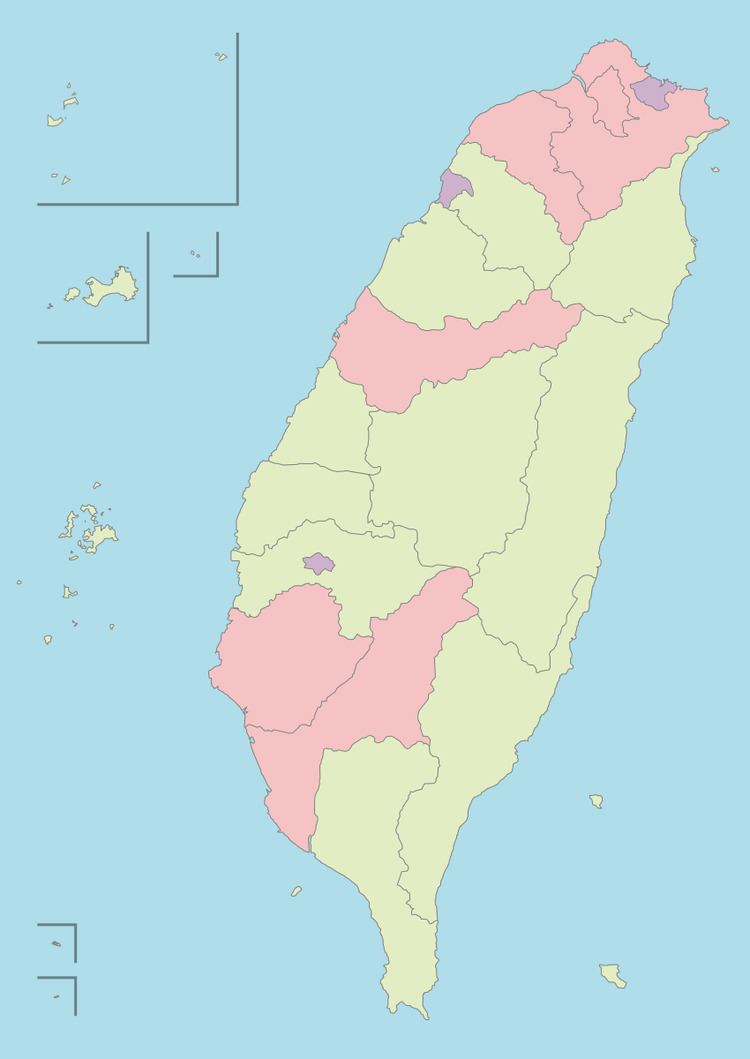Category Unitary state Number 6 | ||
 | ||
Areas Government Local government, Central Government | ||
A special municipality (Chinese: 直轄市; pinyin: zhíxiáshì; Pe̍h-ōe-jī: ti̍t-hat-chhī) is an administrative division unit in Taiwan. Under the administrative structure of Taiwan, it is the highest rank of division and is equivalent to a province. After the streamline of provinces in 1998, the special municipalities along with provincial cities and counties are all directly led by the central government. Currently there are six special municipalities in Taiwan: Kaohsiung, New Taipei, Taichung, Tainan, Taipei and Taoyuan.
Contents
History
In late 1949, the government of the Republic of China lost the Chinese Civil War and was relocated to Taipei, Taiwan. At this time all the special municipalities established in mainland China were lost. There were no special municipalities under the government's effective jurisdiction.
In 1967, Taipei City, the first special municipality in Taiwan was created. Taipei served as the capital of the country since 1949 and was also the most populous city. Territory of the Taipei special municipality includes the original provincial Taipei City and 4 of its neighboring townships in Taipei County, including Neihu, Nangang, Muzha and Jingmei. In the next year, Shilin and Beitou of Yangmingshan Administrative Bureau (a county-equivalent administrative division) were also merged into Taipei.
In 1979, the major international port and industrial city in the southwest of the country — Kaohsiung — were also upgraded to a special municipality. Territory of the Kaohsiung special municipality includes the original provincial Kaohsiung City and Siaogang Township in Kaohsiung County.
At this time, Taiwan was under the martial law era. All national and municipal level elections were not held. The mayors of Taipei and Kaohsiung were assigned by the Executive Yuan (central government), not by elections until 1994. For this point the special municipalities were also called Yuan-controlled municipalities (Chinese: 院轄市; pinyin: yuànxiáshì) at this period.
Following the democratic reforms in the early 1990s, more thoughts of administrative division reforms and reorganizations were widely discussed. The Local Government Act (地方制度法) was passed by the Legislative Yuan (the Parliament) in 1999. This Act regulates the local self-governance bodies and came with some articles to deal with the possible changes of administrative divisions. In the Act also states that cities with population of over 1,250,000 and with significance on political, economic and cultural development may form a special municipality.
The 2007 amendment of Local Government Act states that a county or city with population over two million may grant some extra privileges in local autonomy that was designed for special municipalities. This type of counties are often called quasi-municipalities (準直轄市). Taipei County was the first division within this case. In 2009, another amendment of Local Government Act gave councils of counties and cities the right to file petitions to reform themselves into special municipalities. Four proposals were approved by the Executive Yuan in 2009
The four newly created special municipalities were formally established in December 25, 2010 with the inauguration of the new mayors.
In June 2010, the population of Taoyuan County also grew over 2 million and were qualified for being a quasi-municipality since 2011. The county government also sent a proposal to become a special municipality in 2012. Executive Yuan approved the proposal and the special municipality of Taoyuan were formally established in December 25, 2014.
Currently, there are in total six special municipalities under the central government. The special municipalities cover the top five most populous metropolitan areas in Taiwan and over two thirds (2/3) of the national population.
Current Special Municipalities
There are currently six special municipalities:
Their self-governed bodies (executive and legislature) regulated by the Local Government Act are:
In Taiwanese municipalities, the mayor is the highest-ranking official in charge. The mayor is directly elected by the people registered in the municipality for a duration of four years.
